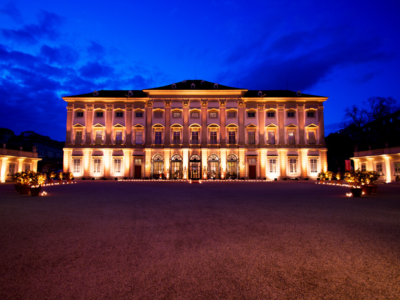
Being over three hundred years old and located in the very heart of Vienna, this Liechtenstein residence represents a symbiosis of nature, architecture and extremely valuable art collections. The impressively renovated Sala Terrena, the Baroque Hercules Hall and the Ladies’ Apartments, together with the beautiful gardens, create the impression of real aristocratic lives, and the local private art collection of the princes of Liechtenstein contains the masterpieces from the Renaissance to the High Baroque.
The land in the Rossau district, which was located behind the then Vienna city walls, was bought by Hans-Adam Andreas I, Prince of Liechtenstein (1657–1712), in 1687. The area first developed as a completely self-sufficient complex of buildings known as Lichtenthal. Today, it represents a unique example of Vienna’s urban planning in the Baroque period. The construction of the Garden Palace began around 1700 and its first architect was Johann Bernhard Fischer von Erlach (1656–1723). However, the interest of Hans-Adam I in the work of Italian masters led to the very rapid engagement of the Bologna architect Domenico Egidio Rossi (1659–1715). The prince’s plan to build a palace villa in the Roman style here was then finalized by Domenico Martinelli (1650–1718). However, Martinelli imprinted an almost classicist cold monumentality on the building. Although it was far removed from Fischer’s original intentions, its impressive style scope and unity fundamentally influenced the entire further development of Viennese Baroque architecture.
The author of the series of frescoes on the ground floor of the palace (Sala Terrena, Ladies’ and Gentlemen’s Apartments) and above both stairs (The Admittance of Military Genius to Olympus and Battle of the Gods and Giants) is the Salzburg painter Johann Michael Rottmayr (1654–1726). The two mentioned paintings were rediscovered and sensitively restored in 2000. The unique feature of the palace is the original stucco decoration of the famous Italian master Santino Bussi (1664–1736), which has been preserved almost in the entire building. The statues and gardens are the work of the Venetian sculptor Giovanni Giuliani (1664–1744).
At the beginning of the 19th century, Johann I Joseph, Prince of Liechtenstein, decided to move most of the works of art, which were originally located in the City Palace in Vienna and on estates in Bohemia and Moravia, to the Garden Palace. Among the moved works of art were famous Decius Mus cycle and The Portrait of Clara Serena Rubens by Peter Paul Rubens, as well as the works of Anthony van Dyck, Raffael, Rembrandt van Rijn and others. In this context, it should be noted that several works exhibited here were created directly to order by the princes of Liechtenstein, such as plaques with the scenes of the Trojan War by Pierre Courteys. In 1807, this unique collection was first opened to the public.
Between 2001 and 2003, a complete reconstruction of the palace took place, costing twenty-five million euro and financed entirely by Hans-Adam II, Prince of Liechtenstein. Renovated to its original beauty, the Liechtenstein Garden Palace, monument of Viennese Baroque architecture, is open to the public only as part of special events.
Capacity 420 seats. Barrier-free entrance ![]()
Parking: Fürstengasse (limited capacity), kryté parkoviště a garáže na Liechtensteinstrasse (paid)